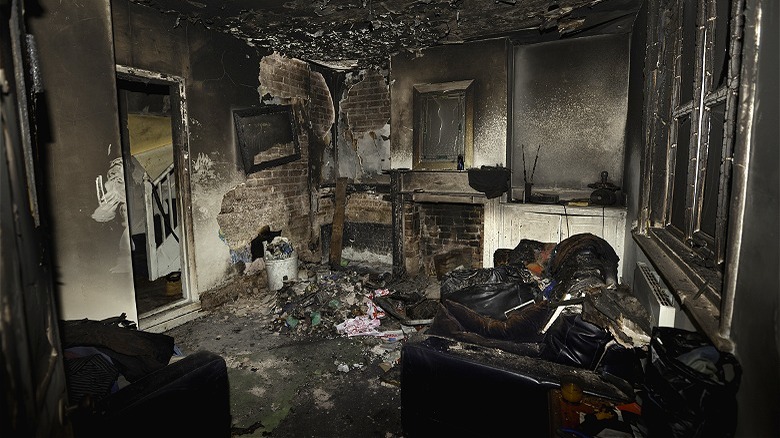How Making A Home Inventory Could Save You Thousands Of Dollars
Let's face it, no one wants to imagine the worst — let alone, plan for it. This can be especially true when it comes to your home. Just the act of imagining a house fire, flood, or even burglary can be anxiety-inducing, leading homeowners to instead imagine that something awful would simply never happen to them. Unfortunately, planning ahead for potential loss can be vitally important, especially in instances of disasters. This brings us to the home inventory, a list of every single thing in your home.
Most people can remember big things like televisions, laptops, and appliances but the hundreds of small things that ultimately make your house/apartment a home might be forgotten. Steve Severaid, president of a public insurance adjusting firm, explained to NerdWallet, "All the stuff that we collect as people over the years ... adds up to hundreds of thousands of dollars oftentimes. And to remember all those little things is nearly impossible." This is why home inventories can be a vital part of any potential insurance claim you might need to make in the wake of a disaster like a fire.
Part of the home inventory process should also include reviewing your existing homeowners (or rental) insurance policy. Make sure that your existing coverage limits match up with your estimated possessions' amount. Remember, while your television might be the most expensive thing in your living room, the cost of replacing the sofa, rug, curtains, and tables, etc. could still end up being significant, so be as thorough as possible.
Creating an inventory of your home
You might be thinking that creating a home inventory is just a simple function of listing everything you own, but doing some additional legwork up front can pay off if and when you ever need to use your inventory. The simplest method is to take a video logging everything in your house, while more thorough methods include creating a comprehensive list (you can even include photos of all items if you choose). For lists, providing a description of the item can be much better than simply the name of the object. Including the make and model when applicable can also help. Similarly, if an item has a serial number, including that in its description can also be helpful. The more specificity you can provide, the less your insurance company can try to disregard items.
Another key piece of information to include in your home inventory is the estimated price of the items listed. Including the purchase date or general time frame in which you purchased the item can also help with dating and pricing an item on your inventory should the time ever come. Obviously, having receipts for large items can also be important, so keeping a digital file of purchase receipts (i.e., in a cloud system) for large-ticket items can be beneficial. Also, remember that keeping your inventory list or physical receipts in your home isn't a great idea since the idea is that, if a fire or floor should occur, you'll probably lose them along with the rest of your belongings.
Other things to keep in mind
When reviewing your existing home insurance policy, it can also be important to review specific categories, especially if you have a collection of something that might belong in a specific high-value category (i.e., watches, jewelry, art). The coverage limits on these kinds of categories can often be much lower than what you might own, so make sure to double-check. Also make sure to review if your policy covers the replacement value or cash value of an item since this can have significant financial differences should you ever need to make a claim.
The term cash value often means the depreciated value of the existing item rather than the cost of replacing it as new. Remember that inflation has made the cost of new items considerably different than when you might've bought something before, even if it was only a few years ago.
Another really important consideration when reviewing your home's inventory list and insurance coverage is checking for disaster insurance coverage. Many insurance companies will make you purchase insurance for flooding, wildfires, or earthquakes separately (largely in the hopes of getting more money from you and/or in the hopes they won't actually be liable to cover your losses in the event of a natural disaster). If you live in a place that's prone to any regular weather and/or disaster events, it can absolutely be worth it to pay more for this special type of coverage. Without it, you could find yourself without your possessions, and without the money to replace them.


